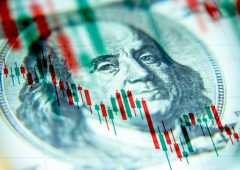U.S. PPI Shows Inflation Cooling, But Trade Policies May Disrupt Progress
14.01.2025 16:51 1 min. read Alexander Zdravkov
Wholesale inflation in the U.S. showed signs of easing in December, offering a glimmer of hope that price pressures may not be accelerating as feared.
The Producer Price Index (PPI), which tracks changes in prices paid to producers, edged up by just 0.2% for the month and 3.3% year-over-year, falling slightly below economists’ expectations.
Energy costs were the primary factor behind the monthly increase, with wholesale energy prices jumping 3.5%. This rise offset otherwise stable pricing trends, as core PPI—excluding the more volatile food and energy categories—remained unchanged from November and held steady at 3.5% annually.
Economist Chris Rupkey of FwdBonds cautioned against celebrating too soon, warning that potential trade policies under President-elect Donald Trump could disrupt inflation trends. Proposed tariffs on key trading partners could lead to higher import costs, ultimately affecting consumer prices. Rupkey suggested that future inflation would largely depend on how these policies unfold, describing the current data as “a small victory” in a larger, uncertain battle.
While December’s inflation figures marked a slowdown compared to November’s 0.4% monthly rise, which was partly driven by soaring egg prices, they still represent the highest annual increase in PPI since February 2023. The slightly cooler-than-expected numbers bring temporary relief, but with economic uncertainty looming, analysts remain cautious about what lies ahead for inflation trends.
-
1
Trump Targets Powell as Fed Holds Rates: Who Could Replace Him?
27.06.2025 9:00 2 min. read -
2
U.S. PCE Inflation Rises for First Time Since February, Fed Rate Cut Likely Delayed
27.06.2025 18:00 1 min. read -
3
Key U.S. Economic Events to Watch Next Week
06.07.2025 19:00 2 min. read -
4
Gold Beats U.S. Stock Market Over 25 Years, Even With Dividends Included
13.07.2025 15:00 1 min. read -
5
U.S. Announces Sweeping New Tariffs on 30+ Countries
12.07.2025 16:30 2 min. read
US Inflation Heats Up in June, Fueling Uncertainty Around Fed Cuts
U.S. inflation accelerated in June, dealing a potential setback to expectations of imminent Federal Reserve rate cuts.
Gold Beats U.S. Stock Market Over 25 Years, Even With Dividends Included
In a surprising long-term performance shift, gold has officially outpaced the U.S. stock market over the past 25 years—dividends included.
U.S. Announces Sweeping New Tariffs on 30+ Countries
The United States has rolled out a broad set of new import tariffs this week, targeting over 30 countries and economic blocs in a sharp escalation of its trade protection measures, according to list from WatcherGuru.
Key U.S. Economic Events to Watch Next Week
After a week of record-setting gains in U.S. markets, investors are shifting focus to a quieter yet crucial stretch of macroeconomic developments.
-
1
Trump Targets Powell as Fed Holds Rates: Who Could Replace Him?
27.06.2025 9:00 2 min. read -
2
U.S. PCE Inflation Rises for First Time Since February, Fed Rate Cut Likely Delayed
27.06.2025 18:00 1 min. read -
3
Key U.S. Economic Events to Watch Next Week
06.07.2025 19:00 2 min. read -
4
Gold Beats U.S. Stock Market Over 25 Years, Even With Dividends Included
13.07.2025 15:00 1 min. read -
5
U.S. Announces Sweeping New Tariffs on 30+ Countries
12.07.2025 16:30 2 min. read


